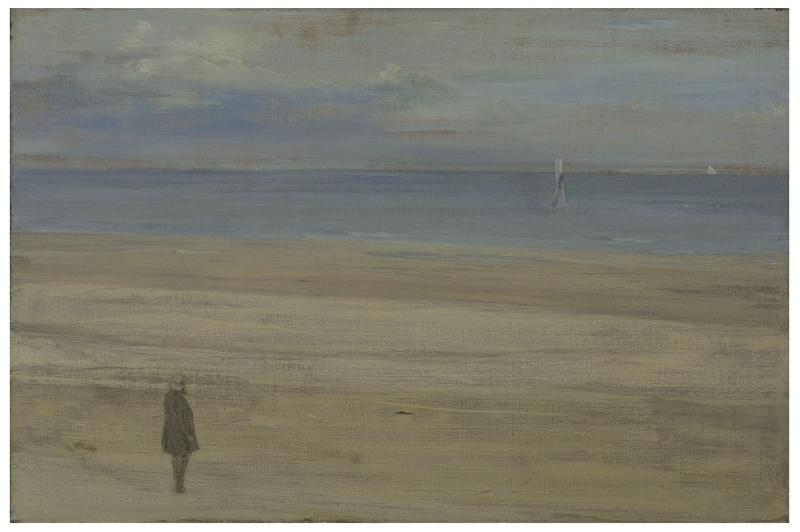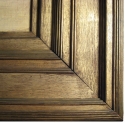Home > Catalogue > Browse > Harmony in Blue and Silver: Trouville << >>
Composition
Courbet's figure was added after the background had dried, and his feet were originally further to the left. The composition has often been compared with that of Courbet's The Seaside at Palavas of 1854 (Musée Fabre, Montpellier). Courbet's work is richer in colour, more thickly painted, and has a diagonal emphasis lacking in Whistler's more two-dimensional composition. The Isabella Stewart Gardner Museum website comments:
'Yet, while it refers to that picture and represents the figure of Courbet within its composition, Harmony in Blue and Silver is a turning point in the emergence of what would come to be Whistler’s mature painting mode, a radical reduction of painting to thin veils of color brushed across canvas. Whistler’s growing commitment to the purely formal elements of painting is apparent in the way in which the calm expanses of sand, sea, and sky approach the abstraction of pure bands of color; yet at the same time, thin washes of a pale lavender color suggest shifting lights and depths in the water and the air.
In this painting, a dynamic tension between surface pattern and the evocation of expansive space is reinforced by the ambiguous direction of the gaze of Courbet’s small figure at the lower left. If the figure’s head is turned toward the right, then he gazes diagonally across the sands, with his “Assyrian” beard visible in profile, though wearing his hat at an oddly precarious angle. Alternatively, the figure might be looking straight out to sea, as the hat’s placement tends to suggest. The ambiguous direction of the figure’s gaze may be taken to relate to the picture’s suspension between flat immediacy and expansive depth: in one reading, the figure directly confronts the flat bands of color; in the other reading, the figure gazes across a sea that recedes toward a vanishing point defined by a sailboat in the middle distance and a second boat on the far horizon.' 1
Technique
It is painted on a fine weave canvas. Whistler's long brushstrokes sweep across the canvas parallel to the picture frame, up to a high horizon. The effect is not really flat, however, for the muted pale colours, set off by the still, straight figure, lend an air of spaciousness to the design.
Conservation History
In 1878 Whistler complained to John Cavafy:
'I gave the picture to your Father! ... after many years it comes back to me in a pretty condition - any quality of light and purity it may possess being utterly lost - so much so that it was almost a question as to whether they were not gone for ever - With very little hope however I set to work and finally manage[d] to clean the little picture - and restore it to its original fairness - and then take the trouble to order for it a frame designed by myself - so that after a long period it is returned to you pretty enhanced in beauty; and as a result, so little is the who[l]e thing cared for, that your Father refuses to pay the frame maker for the frame for my silly gift.' 2
On 12 June 1892, Whistler wrote from Paris to his picture restorer, Stephen Richards (1844-1900),
'you will have brought to you, almost directly, four more pictures by me; I have said that you are the only man fit to touch my work, therefore, you must prove again how right I am, in having this full confidence in you. You will clean and take off the varnish with the utmost care and tenderness - Two of the pictures have not been cleaned since they were first painted. They ought all to come out in the most brilliant condition. … The little Thames picture and the seapiece are painted as well as I remember, in one go and consequently are not so much impasted, therefore will require your utmost care.' 3
Likewise, he told Edward Guthrie Kennedy (1849-1932):
'Take the pictures to Mr. Richards - you know where his place is - He is the only man fit to clean my paintings - and you can tell him so from me … Let him then clean the four and varnish them ... they must be covered with dirt ... He works not only well but quickly ... My own, the Sea piece has got a frame that will do for the present - and I can get a glass here of course - probably it would be safer to travel without.' 4
The butterfly signature, added by Whistler in 1892, has been partly cleaned off.
Frame
1865/1870: the style and whereabouts of the original frame, if there was one, is unknown. It is possible that the frame currently on the picture was the original, but that the surface was altered later.
1878/1879: Foord and Dickinson, 90 Wardour Street, sent Whistler a bill (which was among his bankruptcy papers!) for a frame that may have been for this painting, 'A wainscot reeded frame own pattern gilt with green gold 29¾ x 19½', at £6.9.0, and 'A best white patent plate glass for above frame over inside flat', at £1.3.0. 5 The current Flat Whistler frame bears a Foord & Dickinson label. The account quoted above shows that it originally had a painted panel.
Last updated: 26th November 2020 by Margaret








